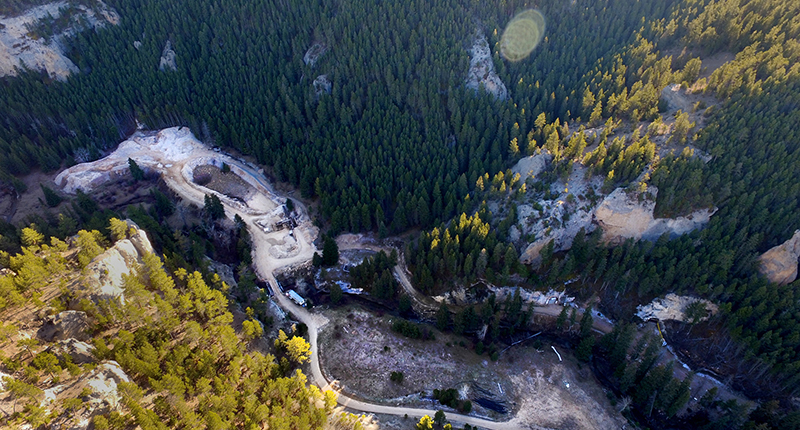The entrepreneur and “Shark Tank” star will share his top tips for success.
Montana Retailer Acquires, Reopens Yogo Sapphire Mine
The Gem Gallery’s purchase of the Vortex mine near Lewistown will allow the jewelry store to bring the high-quality sapphires back to the market.

Bozeman, Mont.--One Montana retailer will soon be bringing more high-quality Yogo sapphires to the market.
The Gem Gallery, a jewelry store located in downtown Bozeman, has acquired the Vortex mine near Lewistown for an undisclosed sum.
The mine has been closed for the past five years after its previous owner, Mike Roberts, died in an accident while inside the mine. He was cleaning fine ore and putting it into the bucket of a front-end loader when rock fell from about 20 feet up and struck him, according to the U.S. Department of Labor’s Mine Safety and Health Administration.
Roberts was a good friend of Gem Gallery owner Don Baide, who told National Jeweler that Roberts had been prodding him to buy the mine for years.
“He harped on it for years,” Baide said. “It got to the point where it was redundant.”
Baide eventually took a team of geologists to the site to map it out, wrote a proposal and gave it to Roberts.
He said Roberts was so excited by his plan for the mine, he immediately started executing it. Talks about purchasing it slowed for a bit, and then things were put on hiatus after his death.
Now, Baide has purchased everything--all rights, claims and equipment--of the Vortex Yogo sapphire mine from Roberts’s wife, Laurie.
Yogo Gulch is one of four major sapphire-producing areas in Montana and was discovered more than 100 years ago, according to the Gemological Institute of America.
Yogo sapphires are known for their uniform, well-saturated blue color, relative absence of inclusions and zonation, and high luster and brilliance in both artificial and natural light, the GIA said. They also have the added advantage of not requiring any heat treatment.
Because of their fine quality, the price differential between Yogo and other fancy Montana sapphires can be significant. Baide said that other Montana sapphires can average about $1,000 per carat, compared with somewhere around $10,000 per carat for a Yogo sapphire.
Yogos also generally come in small sizes, below 2 carats or less, but Baide said that even when they’re bigger in size, they tend to still have a strong, saturated color.
The Vortex mine originally opened in 1984 but was mothballed for a time beginning in 2004, after the operating company at the time became disappointed with production and profitability.
Roberts acquired the mine and its claims in 2008, successfully mining underground
Though the mine shaft was about 300 feet deep, it hadn’t been explored greatly by previous miners to determine the volume of sapphires present. Roberts worked to reach a depth of more than 400 feet while following a vein of Yogo sapphires.
Now, Vortex currently is the largest operating source of Yogo sapphires, according to Baide, who founded Yogo Mining LLC to operate the site.
Baide, who started The Gem Gallery in 1994, will move his primary focus to the mining operations, while his son Jason, who has been serving as the store manager for about a year now, will take over many of his responsibilities at the store.
Initial mining operations will be conducted by a team of six experienced Montanan miners.

The site has a lot of potential, both Don and Jason Baide told National Jeweler.
There are estimates that it goes as far down as 5,000 to 7,000 feet, Jason said, noting, though, that the deeper it goes, the harder the matrix rock gets and the more expensive it is to mine.
There is a large amount of material, but the question then becomes whether or not it is economical to mine deeper.
For now, The Gem Gallery is going to focus on the completion of safety improvements--which are required by the Mine Safety and Health Administration following Roberts’s fatal accident, which the administration determined was caused by the lack of examinations and tests for loose ground conditions after blasting--and inspections and then getting it up and running.
They will aim to have some cut stones available for the holiday season, but the site won’t be fully operational until next year.
And while it’s still too early to tell what production might be, Jason Baide said that their goal would be to “build a longer-term, stable supply,” rather than flooding the market with material, and would keep it to a scale that’s sustainable. To do this, they intend on running the mine on a seasonal basis.
They also will cut the stones themselves, with the elder Baide leveraging a background that includes decades of gemstone cutting expertise to ensure the quality of cut. Yogo Mining will keep everything 2 mm or bigger to cut domestically, preferably by Montana cutters, and then sending anything smaller to international cutters.
And with the mine now in their possession, The Gem Gallery will expand its signature design line and use more Yogos in curated collections from vendors.
It also will help provide the market with fine Yogo sapphires. In fact, while The Gem Gallery will remain the primary outlet for the fine quality stones, it also will supply the trade with the stones as well.
“We think it’s unfair and harmful to Yogo sapphires to say we’re the only ones on the block who have them,” Jason Baide said.
Market Appeal
The timing of the acquisition is perfect for market trends, Jason Baide said, noting that Montana sapphires are popular right now and getting even hotter.
They appeal to the younger consumer’s desire to know the full story of a stone with the ability to trace from mine to market, not to mention its low environmental impact.
Because the Vortex mine is a hard-rock underground mine, it disturbs fewer than five acres above ground, causing minimal surface disturbance and utilizing no harsh chemicals for extraction. The Gem Gallery also has a partnership with the U.S. Forest Service to use the mine’s waste rock as road fill, continuing an agreement that Roberts made.
RELATED CONTENT: Columbia Gem House Merges with Sapphires of MontanaThe Baides also believe that coming at the business from their perspective as retail jewelers--rather than mining and construction backgrounds previous owners have had--will offer a unique advantage.
“You have to be able to sell each stone, and we have the network and connections to help do that,” Jason said. “We also have a loyal customer base that loves Yogo (sapphires).”
His father added: “We’re very realistic. We know that having a stone doesn’t mean it’s an instant sell. We know you have to grade it, cut it and market it.”
They said they’ve been working with American Gemological Laboratories (AGL) to improve its Yogo identification by sending the lab samples of rough and cut Yogo sapphires.
The company’s larger gems will have an AGL report, including an indication of the “Yogo Gulch” origin.
“From a personal standpoint, it is nice to see the Yogo mine producing again,” AGL President Christopher P. Smith said. “This material has always been a favorite of mine. From the production that has been submitted to the AGL for testing, I have been impressed by the number and qualities of Yogo sapphires that we have been seeing. It seems that Yogo will be able to continue producing beautiful gems for existing fans of this material and to make new fans going forward.”
The Latest

The Ukrainian brand’s new pendant is modeled after a traditional paska, a pastry often baked for Easter in Eastern European cultures.

The jeweler has announced a grand reopening for its recently remodeled location in Peoria, Illinois.

The “Strong Like Mom” campaign features moms who work at Tiffany & Co. and their children.


Interior designer Athena Calderone looked to decor from the 1920s and 1930s when crafting her first fine jewelry collection.

During a call about its full-year results, CEO Efraim Grinberg discussed how the company is approaching the uncertainty surrounding tariffs.

Bench jewelers spend years honing their skills, Jewelers of America’s Certification validates their talents.

The free program provides educational content for jewelry salespeople and enthusiasts to learn or refresh their diamond knowledge.

The feedback will be used to prepare other jewelers for the challenges ahead, the organization said.

The online sessions are designed to teach jewelers to use AI tools like ChatGPT and Claude to grow their business.

The opening marks the jewelry retailer’s first location in the Midwest.

The “United in Love” collection offers tangible mementos of hearts entwined with traditional and non-traditional commitment heirlooms.

Robert Goodman Jewelers will hold a “Black Jewelry Designers and Makers” event on April 27.

The announcements follow a tumultuous start to 2025 for WJA, which saw a wave of resignations following controversial statements about DEI.

Editor-in-Chief Michelle Graff answers questions about how the new taxes levied on countries like India and China will impact the industry.

Kenewendo, Botswana’s minster of minerals and energy, discusses closing the deal with De Beers and the work that was missed along the way.

The historic fancy vivid blue diamond set to headline Christie’s Geneva sale next month could sell for up to $50 million.

LVMH CFO Cécile Cabanis also discussed the effects of tariffs so far.

The “Mad Men” and “The Morning Show” star steals jewelry, art, and handbags from his wealthy neighbors in “Your Friends & Neighbors.”

An investigation found that the former managing director of Movado’s Dubai branch overstated and prematurely recorded sales.

The collection pays tribute to the Japanese philosophy of Ma, studying balance, stillness, and the interplay between presence and absence.

Mari Lou’s Fine Jewelry in Orland Park, a suburb of Chicago, is closing its doors.

GIA’s labs in Dubai and Hong Kong are now accepting larger diamonds in light of the “logistical challenges” presented by the new tariffs.

These earrings by Van Cleef & Arpels, featuring the same design as a pair worn by Princess Grace, are up for auction at Woolley & Wallis.

Two experts share how artificial intelligence tools can help retailers run a more efficient business.

“America Telling Time: 150 Years of Bulova” explores the storied history of the American watchmaker.




























